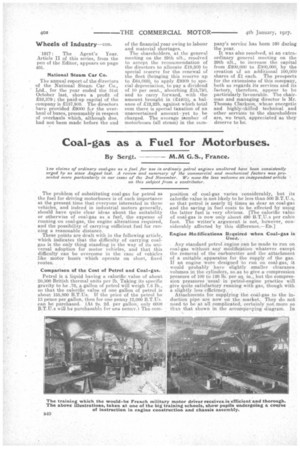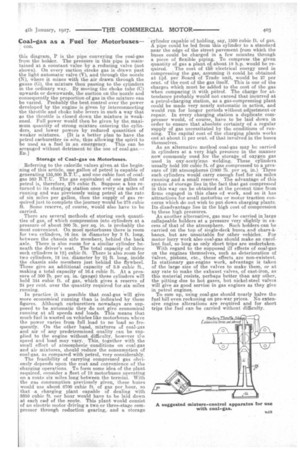Coal-gas as a Fuel for Motorbuses.
Page 12

Page 13

If you've noticed an error in this article please click here to report it so we can fix it.
By Sergt. G.S., France.
lize claims of ordinary coal-gas as a fuel for use in ordinary petrol engines unaltered have been consistently urged by us since August last. A review and summary of the commercial and mechamcal factors was presented more particularly in our issue of the 2nd November. We none the less welcome an independent article on this subject from a contributor.
The problem of substituting coal-gas for petrol as . the fuel for driving motorbuses is of such importance at the present time that everyone interested in these vehicles, and indeed in industrial motors generally, • should have quite clear ideas about the suitability or otherwise of coal-gas as a fuel, the expense of running on coal-gas, the engine alterations required, and the possibility of carrying sufficient fuel for running a reasonable distance. These points are dealt with in the following article,
• which indicates that the difficulty of carrying coalgas is the only thing standing in the way of its universal adoption for motor vehicles, and that this difficulty can be overcome in the ease of vehicles like motor buses which operate on short, fixed.
routes. .
Comparison of the Cost of Petrol and Coal-gas.
Petrol is a liquid having a ealorific value of about • 20,500 British thermal unit8 per lb. Taking its specific gravity to be .76, a gallon of petrol will weigh 7.6 lb., so that the calorific value of one gallon of petrol is about 155,800 B.T.Us. If the price of the petrol be 13 pence per gallon, then for one penny 12,000 B.T.Us. can be purchased. (At 28. 2d. per gallon only 6000 B.T.T.J.s will be purchasable for one nenny:1 The corn position of coal-gas varies considerably, but it calorific value is not likely to be less than 500 B.T.U.s, so that petrol is nearly 21 times as dear as coal-gas and the saving in fuel costs to be effected by using the latter fuel is very obvious. [The calorific value of coal-gas is now oniy about 490 B.T.U.s per cubic foot. The writer's argument is not, however, considerably affected by this difference.—ED.]
Engine Moiifications Required when Coal-gas is
Used.
Any standard petrol engine can be made to run on coal-gas without any modification whatever except the removal of the' carburetter and the attachment of a suitable apparatus for the supply of the gas. If an engine were designed to run on coal-gas, it would probably have slightly smaller clearance volumes in the cylinders, so as to give acompression Pressure of 100 to 120 lb. per sq. in., but the compression pressures usual in petrol-engine practice will give. quite satisfactory running with gas, though with a slightly less efficiency. Attachments for supplying the coal-gas to• the induction pipe are now on the market. They do not need to be at all complicated, certainly not more so than that shown in the accompanying diagram. In
this diagram, P is the pipe conveying the coal-gas from the holder. The pressure in this pipe ie maintained at a constant• value by a reducing valve (not shown). On every suction stroke gas is drawn past the light automatic valve (V), and through the nozzle (N), where it mixes with the air drawn through the gauze (0), the mixture then passing to the cylinders in the ordinary way. By moving the choke tube (C) upwards or downwards, the suction on the nozzle and consequently the proportion of gas in the mixture can be varied. Probably the best control over the power developed by the engine is given by inthrconneeting the throttle and choke tube levers in such a way that as the throttle is closed down the mixture is weakened. Full power would then be given by the. maximum quantity of strong mixture entering the cylinders, and lower powers by reduced quantities of weaker mixtures. (It is a better plan to have the petrol caeburetter in situ, thus allowing the spirit to be used as a fuel in an emergency. This can be arranged without detriment to the use of coal-gas.— ED.)
Storage of Coal-gas on Motorbuses.
Referring to the calorific values given at the beginning of this article, one gallon of petrol is capable of generating 155,800 B.T.U., and one cubic foot of coalgas 560 B.T.U. The gas equivalent of one gallon of petrol is, therefore, 278 cubic ft. Suppose a bus returned to its charging station once every six miles of running and was p'reviously using petrol at the rate of six miles per gallon, then the supply of gas required just to complete the journey would be 278 cubic ft. Some reserve, of course, wbuld also have to be carried.
There are several methods of storing such quantities of gas, of which compression into cylinders at a pressure of about 300 lb. per sq. in. is probably the most convenient. On most motorbuses there is room for two cylinders, 16 ins. in diameter by 3 ft. long, between the chassis side members, behind the back axle. There is also room for a similar cylinder beneath the driver's seat. The total capacity of three such cylinders is 121 cubic ft. There is also roam for two cylinders, 12 ins, diameter by 2 ft. long, inside the chassis side members just behind the flywheel. These give an additional capacity of 3.9 cubic ft.. making a total capacity of 16.4 cubic ft. At a pressure of 300 lb. per sq. in. (gauge) these cylinders will hold 344 cubic ft. of gas, which gives a reserve of 24 per cent, over the quantity required for six miles running.
In practice it is possible that coal-gas will give more economical running than is indicated by these figures. Although carburetters nowadays are supposed to be automatic they do not give economical running at all speeds and loads. This means that much fuel is wasted on vehicles like motorbnses where the Dower varies from full load to no load so frequently. On the other hand, mixtures of coal-gas and air of any predetermined quality can be supplied to the engine without difficulty, however tl,e speed and load may vary. This, together with the email effect of atmospheric conditions on coal-gas and air mixtures, should reduce the consumption of coal-gas, as compared with petrol, very considerably.
The feasibility of carrying compressed gas obviously depends upon the cost and convenience of the charging operations. To form some idea of the plant required, consider a fleet of 18 motorbuses operating on a route six miles long between the termini. With the gas consumption previously given, these bilks would use about 6700 cubic ft. of gas per hour, so that -a charging !slant capable of dealing with 3350 cubic ft. per hour would have to be laid down at each cad of the route. This plant would consist of an electric motor driving a two or three-stage compressor through reduction gearing, and a storage
eylincler capable of holding, say, 1500 cubic ft. of gas. A. pipe could be led from this cylinder to a standard near the edge of the street pavement from which the buses could be charged in a few minutes through a piece of flexible piping. To compress the given quantity of gas a plant of about 18 lap. would be required. The cost of tha electrical energy used in compressing the gas, assuming it could be obtained at 11d. per Board of Trade unit, would be 27 per cent. of the cost of the gas itself. This is one of the charges which must be added to the cost of the gas when comparing it with petrol. The charge for attendance probably would not exceed that incurred at a petrol-charging statioia, as a gas-compressing plant could be made very nearly automatic in action, and would run for longer periods without adjustment or repair. In every charging station a duplicate compressor would, of course have .to be laid down in order to ensure that absolute certainty of a regular supply of gas necessitated by the conditions of running. The capital cost of the charging plants works out at about 11 per cent, of that involved in the buses themselves.
As an alternative method coal-gas may be carried in cylinders at a very high pressure in the manner now commonly used for the storage of oxygen gas used in oxyacetylene welding_ These cylinders usually hold 100 cubic ft. of gas compressed to a pressure of 120 atmospheres (1800 lb. per sq. in.) Three such cylinders would carry enough fuel for six miles running aed a small reserve. The advantage of this system of storage lies in the fact that gas compressed in this way can be obtained at the present time from firms engaged in this class of . work, and so-it has attractions for email motorbus or motor traction concerns which do not wish to put. down charging plants. Its disadvantage lies in the high cost. of compression to these high pressures.
As another alternative, gas may be carried in large collafasable holders at a pressure very slightly in excess of that of the atmosphere_ Such holders can be carried on the top of single-deck buses, and chars-abanes, but are unsuitable for other vehicles. For motor lorry work also coal-gas should make an excellent fuel, so long as only short trips are undertaken. With regard to the supposed ill effects of coal-gas on the engines themselves, such as deterioration of valves, pistons, etc., these effects are non-existent. In stationary gas-engine work, advantage is taken of the large size of the valves to make them, or at any rate to make the exhaust valves, of cast-iron, as this material resists, perhaps better than any other, the pitting due to hot gases, but nickel-steel valves will give as good service in gas engines as they give in petrol engines.
To sum up, using coal-gas should nearly halve the fuel bill even reckoning on pre-war prices. No extensive engine alterations are reqaired and for short trips the fuel can -be carried without difficulty.




















